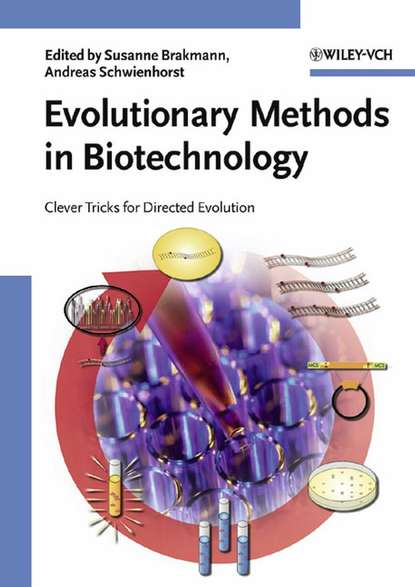Книга "Эволюционные методы в биотехнологии" описывает применение молекулярной эволюции в лабораториях биотехнологии с помощью миниатюризации и высокопроизводительных технологий анализа. Авторы рассматривают этот подход как мощный инструмент, который может быстро привести к желаемому результату, даже если другие методы не сработали. Книга описывает в деталях ключевые шаги успешной эволюционной биотехнологии: от создания библиотек методом случайной или направленной мутагенеза до методов скрининга и отбора. В ней также представлены ценные советы по устранению распространенных проблем.
Книга также описывает современные методы дисплея пептидов и белков на поверхности, выборочное обогащение нуклеиновых кислотных аптамеров и высокопроизводительное скрининг биокатализаторов в промышленности. Кроме того, рассмотрены методы компьютерного моделирования для инженерии белков и РНК в сравнении с методами витро.
Отдельная глава посвящена патентным правилам в отношении биотехнологических инноваций, полученных с помощью направленной эволюции. В дополнение к книге прилагается CD-ROM с программными инструментами для проектирования библиотек, выбора позиций мутагенеза и различных прогностических алгоритмов.
В целом, данное практическое пособие является незаменимым инструментом для каждого ученого, работающего в этой интердисциплинарной области исследований.
Review: This book, "Evolutionary Methods in Biotechnology", written by Susanne Brakmann, discusses the miniaturization of methods in biotechnology that led to increased applications of molecular evolutionary techniques in biosciences laboratories. The author describes how evolutionary approach brings desirable results into play where previous methodologies have failed, illustrating all key steps from random or targeted genetic mutageneses to screening and choosing methods. Within this book valuable stories are outlined on how to troubleshoot common issues of genetic engineering. There is emphasis on explaining current technological trends in paper display of biochemical compounds and the selective isolation of aptamer holders and new experiments of high-resolution selective screening for industrial biolabels. Again there is debate about competitability to program based techniques for protein/RNA engineering on virtual system. Alongside these discussions, an issue in the area of patents for biotechnologies consequences of directional evolution is covered. An additional bonus is a disc that holds software design of libraries, choosing locations for mutagenized sources, and some predictive programs. Overall, this guidebook provides a professional understanding of every researcher who works in their evaluations.
Evolution as a tool of genome engineering offers great opportunities in the life sciences laboratory but also poses challenges. Starting with the concepts of directed evolution conceived on the basis of solid knowledge of molecular mechanisms this book allows the reader to learn not only the "how" but also the "why" of this powerful technique. High throughput strategies, mutagenesis techniques, and selectable markers are explored at great length with emphasis on their rational application. This important insight into the growth of new protein technologies, in particular for aspects related to patents, is accompanied by hints to solving frequently emerging problems during the course of experiments. To make the wealth of biological information that this volume contains manageable the authors include sections on how to apply statistical methods to deal with random errors. Central components of any directed evolution strategy have become so routine that the intricacies really only matter to green hands, which is why the helpful section on purposefully chosen examples of biosynthetic models ll the gaps between the theoretical outlook and its actual subject matter. Long overdue, impressive knowledge portrayed a viable way of approaching the growing gap between the challenging potential of directed biochemical evolution an predictable and sustainable realizations of advance solutions. The often debated Patentability of elaborately evolved genes, once thought difficult to address, has been investigated and made accessible to others, hopefully resulting in increased acceptance and use of evolution as chemistry in the world of biotechnology.
Электронная Книга «Evolutionary Methods in Biotechnology» написана автором Susanne Brakmann в году.
Минимальный возраст читателя: 0
Язык: Английский
ISBN: 9783527604623
Описание книги от Susanne Brakmann
Miniturization and high throughput assay technology have brought the power of molecular evolution to the bioscience laboratory. Applied wisely, the evolutionary approach can quickly yield the desired result even where other methods have failed. From library generation by random or directed mutagenesis to screening and selection techniques – the crucial steps for successful evolutionary biotechnology are described in detail in this practical guide that also includes valuable troubleshooting hints on frequently encountered problems. Modern methods for the surface display of peptides and proteins, selective enrichment of nucleic acid aptamers and high-throughput screening of industrial biocatalysts are explained, and computer-based methods for in silico protein and RNA engineering are described as an alternative to in vitro approaches. A special section covers the patenting regulations with regard to biotechnological innovations derived from directed evolution. As an added bonus, a CD-ROM is included that contains software tools for library design, selection of mutagenesis positions, and various predictive algorithms. In short, this practice oriented handbook is an indispensable tool for every scientist working in this interdisciplinary research area.



















